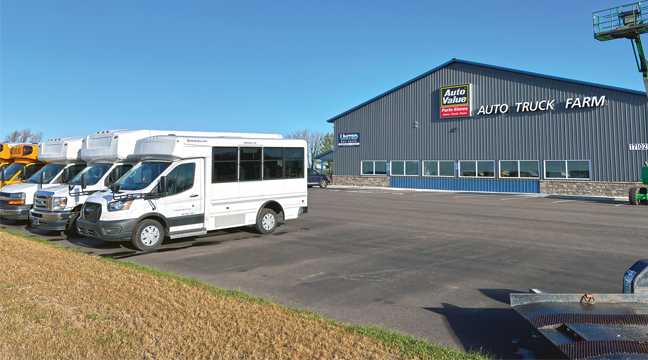With the decommissioning of Sherco Units I and II, transportation has been considered one of the key elements in successfully transitioning to an industry based economy. SEH was asked by the Becker City Council to study several items relating to transportation including: frontage roads and rail spurs in the industrial park, the realignment and positioning for an interchange of Co. Rd. 8 to Hwy. 25, the realignment of the frontage road on the commercial side of Hwy. 10 and cleaning up entry points to Hwy. 10.
Scott Lange and Mike Kotila from SEH were present at Tuesday’s council meeting to present their findings and course of action.
Industrial Rail Study
Lange stepped forward to report on the rail findings of the study. He noted the report was drafted and subsequent comments from staff and council at a previous workshop were implemented.
The city has advantages in that it has easy access to rail and available property, Lange said. He pointed out there are two anticipated types of rail users in Becker — manifest and unit service.
Manifest service involved local trains bringing in and taking out a couple of cars at a time. Unit service involved a minimum of 100 cars carrying the same product coming in as one unit and going out as one unit (ala Sherco).
Visuals were presented by Lange to council to show proposed routes for future train tracks with three phases of development proposed.
The initial manifest service to Lot 1 of the study would cost approximately $4 million. To extend manifest track to Lot 2 of the study, it would be an additional $1.5 to $2 million.
The final phase would be for additional unit train service to be installed as needed depending on end user and the needs of Xcel Energy. This cost was estimated at approximately $10.5 million.
Lange said there was discussion at the workshop about the layout and the potential blocking of Liberty Lane due to rail traffic. Ultimately, he said, the project would be driven by development and end user investment would be made as needed.
Discussion at the workshop questioned if a study had been completed of businesses needs in regards to rail. Lange said Sherburne County was completing such a study with a grant from the Initiative Foundation.
It was also questioned whether a team track had been looked into. A BNSF rail representative noted the concern with team tracks was “liability and who would take that on?” There was typically one owner with all other users holding contracts.
With that being said, the track design should be finalized based on the actual end users.
There was lots of discussion regarding the crossing of Liberty Lane with a new rail line. It was noted although not ideal, it needed to be done to accommodate future growth. The intent would be for trains to clear Liberty Lane before stopping. Existing businesses would be worked with to make sure tracks were not tied up at key times during the day.
Several alternatives were looked at and it was suggested to build Liberty Lane over the tracks.
The discussion then turned to Northern Metal Recycling and what their needs would be. NMR representation said they would start with manifest cars. At this time there was only one steel plant in the U.S. that was capable of accepting unit trains. They were still looking into the possibility of unit trains in the future.
BNSF expected three to four trains per week with the schedule readjusted as volume grows. One train would bring in cars for multiple customers.
Streets Study
Kotila presented the streets portion of the study.
He noted full access to Hwy. 10 would be provided at Liberty Lane, Hancock Street and Co. Rd. 8. Part of the study focused on the realignment of Co. Rd. 8 to Hwy. 25 with several scenarios presented creating different size parcels.
Kotila presented visuals of the various scenarios to council and the public in attendance.
The cost of new roadways was expected to be approximately $2.5 to $3 million per mile, he said. Additionally, it was proposed that Edgewood Street at Hwy. 10 be closed with 151st Street connecting into Edgewood or vice versa and coming out on the front or back side of the Sherburne County Maintenance shop on Hwy. 25.
Kotila said right of way costs had not been figured but an estimate of acreage required would be added to the final report.
Lots of discussion occurred regarding MnDOT and their role and the type of intersection — whether it be a controlled intersection through stop lights or an overpass and the angle of the crossing.
To realign Co. Rd. 8 at a right angle would involve less traffic disruption as the existing road could be used while the new route was constructed. Aligning Co. Rd. 8 using Becker Twp. 52 would cause road closures and smaller lots.
Kotila said the right angle realignment would better position the city for commerce with better flow and larger, flat, stable lots that could be easily built upon. There was concern expressed over Becker becoming a pass through city if an overpass were built. It was suggested that putting in a stop light would make people slow down and stop in the city.
Co. Rd. 8 was then discussed as to its suitability for moving larger amounts of traffic. Kotila said the county engineer noted it was scheduled to be rehabilitated in 2018 with the repaving and widening of shoulders and the possible addition of bypass lanes.
There was more discussion regarding the closing of Edgewood at Hwy. 10 and the inconvenience it would cause residents. The realignment of Edgewood and 1st Street was meant to drive traffic through the Becker commercial district and also provide growth potential for the commercial district, Kotila said. Additionally, there was concern expressed over preserving the possible future fairgrounds location.
Other concerns over Edgewood’s closing included it could drive more traffic through Bradley and the Sherburne Avenue intersections. Also, if an overpass were built, it was suggested Edgewood could be tied into the off ramp for Hwy. 10 for quicker access.
The problem this posed was that a portion of Edgewood would then become a one-way street, making reverse traffic difficult. This type of configuration was typically only used in constrained conditions and would likely sacrifice a portion of the commercial district. The idea behind the proposed configurations was to extend the commercial district.
Next Step?
At the workshop, City Administrator Greg Pruszinske said the city would continue to talk about alignments with input from all partners. Depending on the final alignment of Co. Rd. 8, the vacating of Twp. 52 could be a discussion in the future.
With Tuesday’s acceptance of the report, Pruszinske noted it did not mean authorization was given to begin any work.
“This would be a living document that could be superseded as development and designs came forward,” he said. “This was a starting point for conversations.”










